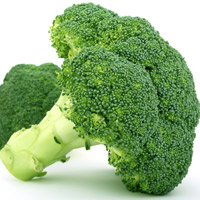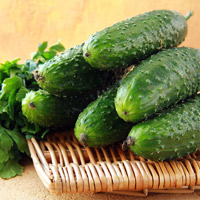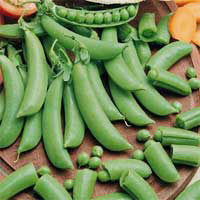Vegetable Tips |
 |
Beans - This traditional crop loves plenty of water in hot weather. There are several types, snap, bush and pole. Bush beans make an attractive border to any garden. Place along the edge of fences or place teepees around them to give them something to grab on to and grow upwards. They produce particularly large yields that are perfect fresh, frozen or canned. The best tip for beans, is pick early and pick often. As the larger pods are removed, several new ones appear to replace them quickly. We recommend 5-6 plants per person for the average family. |
 |
Broccoli – This member of the cabbage family prefers cool temperatures, and can tolerate light frost. The flowers are best eaten before they open, once they go to seed they loose their flavor and become inedible. Harvest when heads are compact and the buds are tight. Cut 6-8” below the heads to harvest as much of the tender delicious stems as possible. After the first center stalk is harvested, side shoots appear and develop into new heads. 4-5 Plants per person is recommend for the average family. |
 |
Cabbage – This cool weather crop is perfect for spring and fall harvests. Plant after the danger of frost has passed, or young plants become fibrous and tough. Place 12-18”apart in rows. Cabbage heads thrive in cool soil, for best results try insulating the dirt with a layer of straw or mulch. Harvest when the heads are firm, full and tight. Suggest 2-3 plants per person for the average family |
 |
Cauliflower – Another member of the cabbage group that requires rich soil, and constant moisture. It can be heat sensitive, and prefers cooler growing locations. When heads are 3” across they need to be blanched. This can be done by tying the leaves over the head to ensure that the heads stay white. Heads can be harvested two to four weeks later when they are compact and have a fairly smooth texture. Allow 2-3 plants per person. |
 |
Cucumbers - Cucumbers do best in rich moist soil. Plants need to be watered throughout the growing season; under watered plants tend to produce undersized, misshaped fruits. Mulching helps to keep plants moist, and to prevent fruits from discoloring when lying on the ground. Cucumber vines are notorious climbers. Place along fences or trellises to save room in small spaces. Place stepping stones in your garden and train the vines around them. Cucumbers are best picked young, once they turn yellow when the seeds harden and loose thief flavor. Pick often to stimulate new growth. Recommend?? per person.. |
 |
Eggplant - Eggplants love a long warm growing season. They can tolerate frost more than most vegetables. Harvest while fruit is plump and glossy. When it looses it’s sheen it is over ripe and can taste bitter. Three to six plants will yield enough fruit for the average family. |
 |
Lettuce - To keep your lettuce tender and free from bitterness, give your plants plenty of water, and frequent doses of nitrogen rich fertilizer. For best results, plant in an area with some shade. Recommend 10-12 heads for the average family. To harvest pick outer leaves and let center keep growing. If you cut leaves or head an inch or two above stem you can get a second harvest |
 |
Onions. Onions thrive in loose nutrient rich soil. Break up the soil, and amend with manure or compost before planting. To harvest, bend the tops over when they start to yellow and wait for them to dry. Once the tops are brown, dig them up and let them dry for a week or so. Braid the tops together and hang in a cool airy place to dry they will keep for several months. |
 |
Peas - Peas will grow in just about any soil type, but thrive when there is some compost or organic matter. Make sure they get plenty of water, mulch often helps to retain moisture. Peas tend to grow tall, so make sure they have something like a fence or a trellis to climb. Pick peas when the pods are well filled but the peas inside are not hard. If left on the vines to long, they become tough and loose their flavor. They are best cooked right after picking. |
 |
Peppers – Sweet or hot, there is a pepper for almost every culinary need. They may have different characteristics, but they have very similar growing habits. They do best in slightly acidic soil, full sun, and need plenty of moisture. If peppers do not get enough moisture, they tend to drop their flower sets. Pepper fruits tend to set up when nighttime temperatures are between 60-70 degrees. Be careful when harvesting. Peppers tend to have delicate branches, use a knife to remove the fruits to avoid snapping off a branch when picking. Stop fertilizing after flower buds appear, extra nutrients can prevent peppers from forming. |
 |
Tomatoes - Need a long growing season with moderate temperatures, night time lows need to between 60 to 75 degrees for tomato flowers to set. Grow along a trellis or in a tomato cage in order to have a secure base to stake the plant as it grows. Weather you choose a canning or a salad variety, we recommend three to five plants of each different variety for the average family. Most varieties of tomatoes are “indeterminate”, which means they will continue to grow taller all season. Any tall growing indeterminate tomato will benefit from a cage, to support their growth and keep fruit away from the ground. |
 |
Watermelons - Plant watermelons in mounds about 3-4” tall and about 12-18” wide. Watermelon plants tend to have shallow roots that do not like to get to wet. If planted in a low spot they may get to wet and the roots could rot or be prone to disease. |